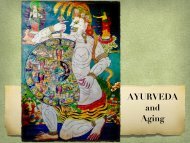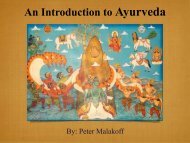How Thoreau's Walden Pond Mixed with the Ganges and Yoga Came to America with Swami Vivekananda
One early morning in 1846, during the coldest days of a New England winter, Henry David Thoreau looked out the window of his small cabin on Walden Pond and saw men cutting its ice into blocks. That ice was hauled by horse to a railroad that ran across the western edge of Walden Pond, packed into a boxcar, taken to Boston and loaded onto a clipper ship that sailed to Calcutta, India, arriving about four months later. Once there, that ice was purchased by grateful members of the East India Company. Thoreau had witnessed a small part of the global ice trade between New England and India that took place during the latter part of the nineteenth century. When Thoreau considered the ice trade, his vision sailed on metaphors far beyond the scope of business. The waters he imagined flowed both east and west and carried not just natural elements, but culture, religion and philosophy as well. He envisioned that after arriving in Calcutta, the New England ice of Walden Pond would eventually melt and run downhill where it would join with the sacred water of the Ganges. He wrote in Walden: "It appears that the sweltering inhabitants of Charleston and New Orleans, of Madras and Bombay and , drink at my well. In the morning I bathe my intellect in the stupendous and cosmogonal philosophy of the , since whose composition years of the gods have elapsed, and in comparison with which our modern world and its literature seem puny and trivial; and I doubt if that philosophy is not to be referred to a previous state of existence, so remote is its sublimity from our conceptions. I lay down the book [Bhagavad-Gita] and go to my well for water, and lo! there I meet the servant of the Bramin, priest of and and who still sits in his temple on the Ganges reading the , or dwells at the root of a tree with his crust and water jug. I meet his servant come to draw water for his master, and our buckets as it were grate together in the same well. The pure Walden water is mingled with the sacred water of the Ganges." This book tells the story of these waters . . .
One early morning in 1846, during the coldest days of a New England winter, Henry David Thoreau looked out the window of his small cabin on Walden Pond and saw men cutting its ice into blocks. That ice was hauled by horse to a railroad that ran across the western edge of Walden Pond, packed into a boxcar, taken to Boston and loaded onto a clipper ship that sailed to Calcutta, India, arriving about four months later. Once there, that ice was purchased by grateful members of the East India Company. Thoreau had witnessed a small part of the global ice trade between New England and India that took place during the latter part of the nineteenth century.
When Thoreau considered the ice trade, his vision sailed on metaphors far beyond the scope of business. The waters he imagined flowed both east and west and carried not just natural elements, but culture, religion and philosophy as well. He envisioned that after arriving in Calcutta, the New England ice of Walden Pond would eventually melt and run downhill where it would join with the sacred water of the Ganges. He wrote in Walden: "It appears that the sweltering inhabitants of Charleston and New Orleans, of Madras and Bombay and , drink at my well. In the morning I bathe my intellect in the stupendous and cosmogonal philosophy of the , since whose composition years of the gods have elapsed, and in comparison with which our modern world and its literature seem puny and trivial; and I doubt if that philosophy is not to be referred to a previous state of existence, so remote is its sublimity from our conceptions.
I lay down the book [Bhagavad-Gita] and go to my well for water, and lo! there I meet the servant of the Bramin, priest of and and who still sits in his temple on the Ganges reading the , or dwells at the root of a tree with his crust and water jug. I meet his servant come to draw water for his master, and our buckets as it were grate together in the same well. The pure Walden water is mingled with the sacred water of the Ganges."
This book tells the story of these waters . . .
Create successful ePaper yourself
Turn your PDF publications into a flip-book with our unique Google optimized e-Paper software.
Rabindranath Tagore<br />
Rabindranath Tagore (1861-1941) was <strong>the</strong> youngest<br />
son of Debendranath Tagore, a leader of <strong>the</strong><br />
Brahmo Samaj, which was a new religious sect in<br />
nineteenth-century Bengal <strong>and</strong> which attempted<br />
a revival of <strong>the</strong> ultimate monistic basis of Hinduism<br />
as laid down in <strong>the</strong> Upanishads. He was educated<br />
at home; <strong>and</strong> although at seventeen he was<br />
sent <strong>to</strong> Engl<strong>and</strong> for formal schooling, he did not<br />
finish his studies <strong>the</strong>re. In his mature years, in addition<br />
<strong>to</strong> his many-sided literary activities, he<br />
managed <strong>the</strong> family estates, a project which<br />
brought him in<strong>to</strong> close <strong>to</strong>uch <strong>with</strong> common humanity<br />
<strong>and</strong> increased his interest in social reforms.<br />
He also started an experimental school at Shantiniketan where he tried<br />
his Upanishadic ideals of education. From time <strong>to</strong> time he participated in <strong>the</strong> Indian<br />
nationalist movement, though in his own non-sentimental <strong>and</strong> visionary<br />
way; <strong>and</strong> G<strong>and</strong>hi, <strong>the</strong> political fa<strong>the</strong>r of modern India, was his devoted friend.<br />
Tagore was knighted by <strong>the</strong> ruling British Government in 1915, but <strong>with</strong>in a few<br />
years he resigned <strong>the</strong> honor as a protest against British policies in India.<br />
Tagore had early success as a writer in his native Bengal. With his translations<br />
of some of his poems he became rapidly known in <strong>the</strong> West. In fact his fame attained<br />
a luminous height, taking him across continents on lecture <strong>to</strong>urs <strong>and</strong><br />
<strong>to</strong>urs of friendship. For <strong>the</strong> world he became <strong>the</strong> voice of India's spiritual heritage;<br />
<strong>and</strong> for India, especially for Bengal, he became a great living institution.<br />
He received The Nobel Prize in Literature in 1913<br />
– From Nobel Lectures, Literature 1901-1967, Edi<strong>to</strong>r Horst Frenz, Elsevier<br />
Publishing Company, Amsterdam, 1969<br />
Related Glossary Terms<br />
Bengali Renaissance<br />
Index<br />
Find Term<br />
Chapter 1 - <strong>How</strong> <strong>Thoreau's</strong> <strong>Walden</strong> <strong>Pond</strong> <strong>Mixed</strong> <strong>with</strong> <strong>the</strong> <strong>Ganges</strong> <strong>and</strong> <strong>Yoga</strong> <strong>Came</strong> <strong>to</strong> <strong>America</strong> <strong>with</strong> <strong>Swami</strong> Vivekanan


















